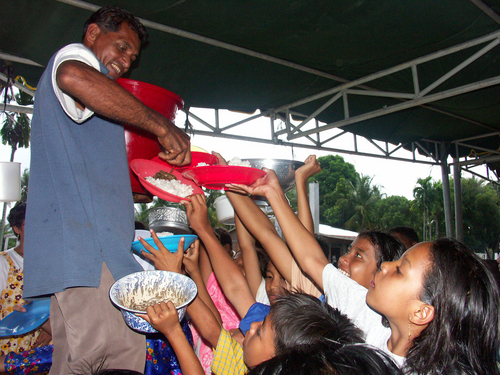Indonesia tsunami: Death toll rises to nearly 1,350
The number of people known to have died in Indonesia in Friday’s earthquake and tsunami has risen to 1,347, disaster response officials say.
The death toll jumped on Tuesday from a previously confirmed figure of 844.
The 7.5-magnitude quake struck just off the central island of Sulawesi, setting off a tsunami that engulfed the coastal city of Palu.
Police are guarding shops against looters as people desperately search for food, fuel and water.
Officers initially took a lenient approach to survivors seizing basic goods, deputy national police chief Ari Dono Sukmanto said, but some people have since been arrested for stealing computers and cash.
“After day two the food supply started to come in, it only needed to be distributed,” he said. “We are now re-enforcing the law.”
Humanitarian relief convoys entering the city are being escorted by soldiers and police.
And there are fears some survivors may still be trapped under the rubble of buildings.
‘A volley of shots and tear gas’
Jonathan Head, BBC News, Palu
Everyone we meet in Palu is focused on trying to get basic goods for their families. All normal services in the town have broken down and there’s little running water, power, food or drinking water. People are desperate.
We saw one group of armed police guarding a shop, being pressed by local people to let them in.
Suddenly the police shouted, warning everyone to back off, followed by volleys of shots fired in the air and tear gas. Some of the men threw stones at the police; for a moment it seemed it might escalate.
Yet an hour later the police backed down and let the crowd in. The atmosphere was transformed, from anger to jubilation as people came running down the street clutching shopping bags.
The police tried to stop people taking non-food items – some were made to empty the sacks bulging with commandeered produce, and hand over plastic toys and toiletries.
One officer wearily told me it was his responsibility to protect the shop – but what could he do when people needed so much?
Are there still hopes of finding survivors?
Indonesian Red Cross officials have told the BBC that the bodies of 34 Indonesian students were found under a church buried by a mudslide.
They were among a group of 86 students reported missing from a Bible camp in the Jonooge Church Training Centre. The whereabouts of the other 52 students are not known.
“The mud conditions in that area are terrible, we have to walk about one and a half hours to reach [the mudslide area], that makes it very difficult,” Ridwan Sobri, a spokesperson for the Indonesian Red Cross told the BBC.
Mr Sobri said the identities and ages of the students could not yet be confirmed.
Rescuers are also still hunting for survivors in the ruins of a four-storey hotel in the city.
An estimated 50 people were inside the Hotel Roa Roa when it collapsed. Teams have so far recovered three survivors and nine bodies.
Rescue team leader Agus Haryono said they were using acoustic detectors to try to locate more survivors.
He said concrete and metal cutters were helping to clear the debris but added: “We have to be very careful so we don’t risk hurting any survivors.”
President Joko Widodo has called for reinforcements, telling the national search-and-rescue agency to send more police officers and soldiers into affected districts.
“There are some main priorities that we must tackle and the first is to evacuate, find and save victims who’ve not yet been found,” he said.
Why are people struggling to get help?
Across Palu, a damaged bridge, blocked roads, a partially closed airport and broken telecommunications have made it difficult to bring help into the affected area, and impossible to contact more remote regions
With hospitals damaged, injured people have been treated in the open and at least one military field hospital has been set up.
The military has taken over the airport to fly aid in, and injured people and other evacuees out.
But for thousands of people wanting to get the first commercial flight out of Palu, the wait continues.
“I’d get a plane anywhere. I’ve been waiting for two days. Haven’t eaten, barely had a drink,” 44-year-old food vendor Wiwid told Reuters.
On Monday, 3,000 to 5,000 people who wanted to be evacuated from Palu swarmed the airport hoping to hitch a ride on a military Hercules plane. The military arranged for them to depart on ferries instead.
The United Nations Office for the Co-ordination of Humanitarian Affairs says there are nearly 200,000 people in urgent need of assistance, about a quarter of them children.
Many are in areas that are not the main focus of government recovery efforts, it adds.
In the hills above Palu, volunteers are filling a vast grave with the bodies of the dead.
They have been told to prepare for 1,300 victims to arrive.
Why was the disaster so bad?
The 7.5-magnitude quake occurred at a depth of 10km (6.2 miles) just off the central island of Sulawesi at 18:03 (10:03 GMT) on Friday, setting off a tsunami.
The earthquake was powerful but shallow and with more lateral than vertical movement, not typically the kind of tremor that sets off tsunamis.
Vice-President Jusuf Kalla has said the final death toll could be in the thousands, while the Red Cross estimates that more than 1.6 million people have been affected.
What was Palu like?
- Bustling city with a population of approximately 350,000 people, with many banks and supermarkets
- Situated in a rain shadow – where there is very little precipitation – and one of Indonesia’s driest places
- Near the popular beach area of Tanjung Karang
- Served by a busy regional airport

